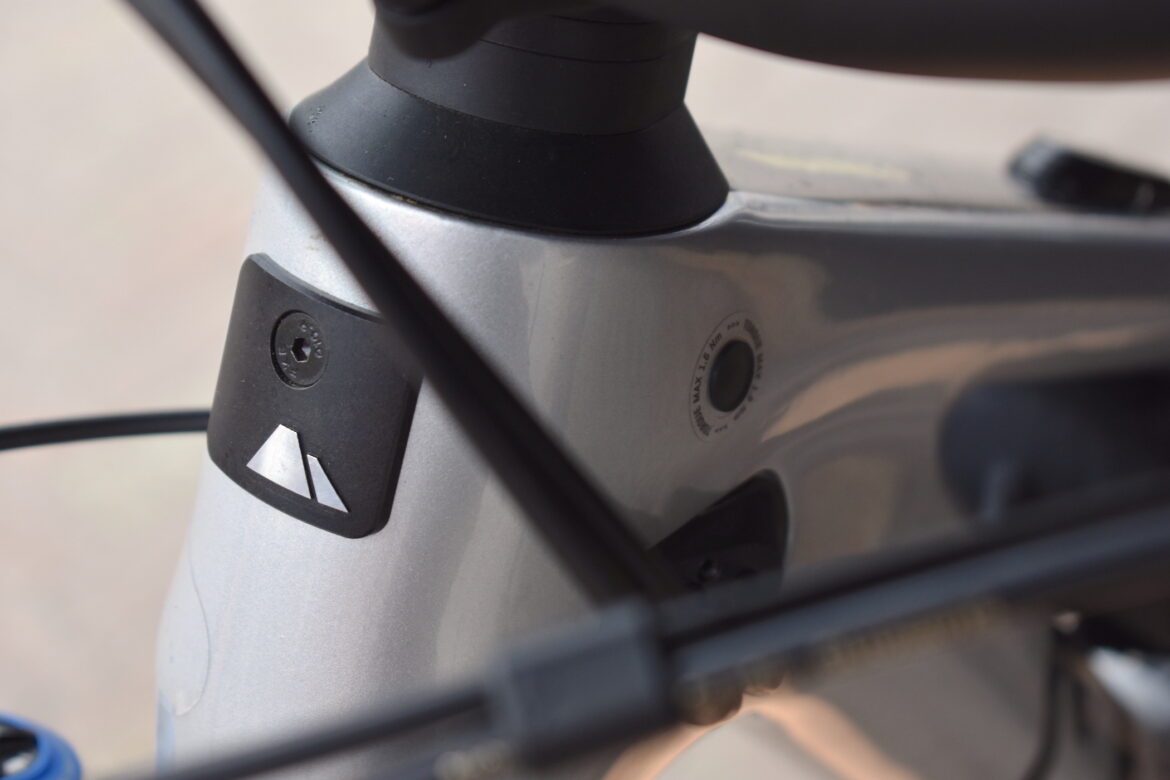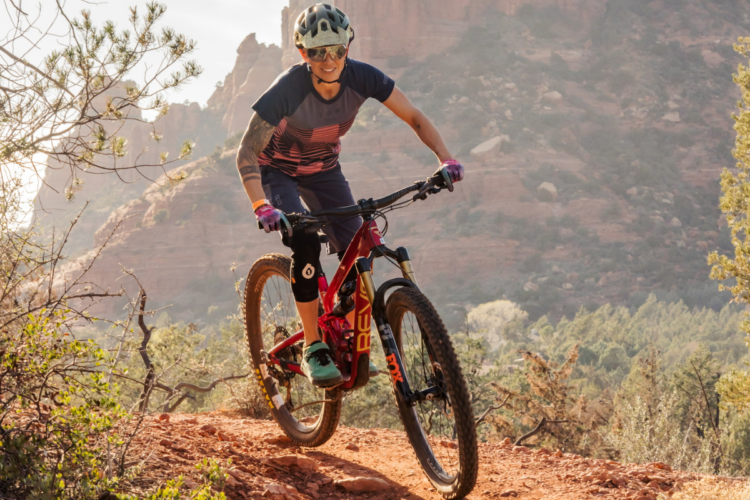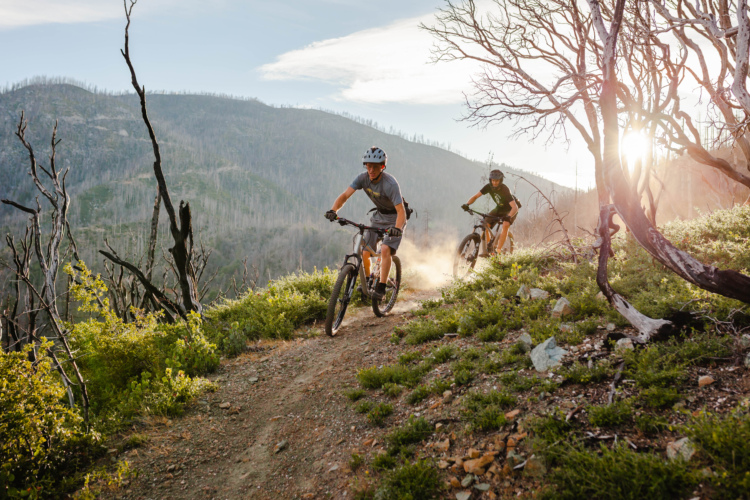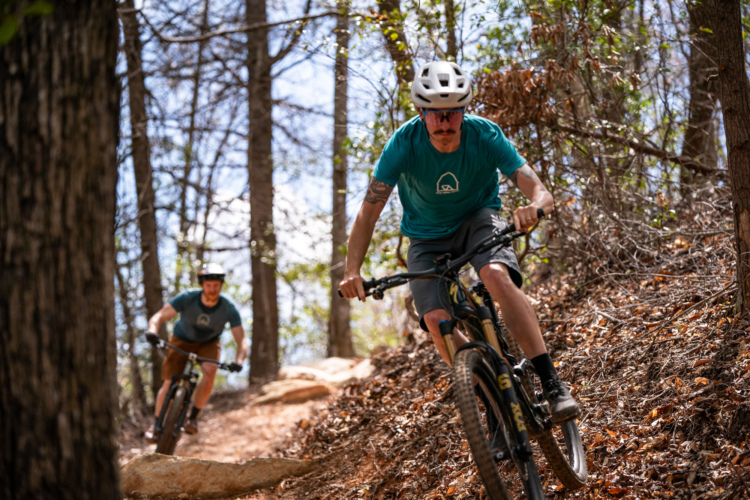Canyon’s K.I.S system — which stands for Keep It Stable — debuted last fall. Mountain bikers can be a fickle bunch, and while we love new technology, some of us eschew new ideas that differ from the norm, while accepting rehashed versions of the same old tech. However every now and then, new ideas stick; after all, everything was new at one time. Canyon’s K.I.S steering tech falls into that latter camp of new ideas, but time will tell if it sticks or not.
While in Whistler for Crankworx last month I tested a Canyon Spectral:ON e-bike retrofitted with a 3D-printed K.I.S system. The K.I.S. system is currently factory fitted to just one Canyon bike model — the Spectral CF 8 K.I.S. — where it’s fully integrated into the top tube. Unlike the integrated K.I.S. system, the one I tested was 3D-printed and zip tied to the bike’s top tube.

What is K.I.S?
K.I.S is a steering stabilizer system – not a steering damper. A steering damper slows down steering input similar to a fork damper and typically has little or no effect on low-speed input. Steering dampers have been tried in the past and never really caught on. K.I.S instead uses a relatively simple spring system to bring the steering back to center, affecting steering at all speeds and effectively stabilizing things. The use of a cam block also affects the leverage rate, a little like a suspension linkage. Check out the article we wrote at launch here for more detail.
At the time of the launch, many online commenters complained the system adds extra complication to the bike. However, in my opinion it’s not a lot of extra complication; it’s actually pretty simple. Since the Canyon folks had outfitted the bike I rode with an external prototype version, though with the same springs, cam etc. as the production version, I was able to see it in all its glory. As a bike mechanic, I’m skeptical of anything that makes maintenance more difficult, and looking at the K.I.S system, I’m not too worried.
The cam block simply clamps to the steerer with one bolt, and there aren’t any moving parts apart from a couple of springs and polymer straps. It would appear that there’s not a whole lot to go wrong, and it adds one, maybe two extra steps to fork removal. There may be more refinements in the future, but for now it’s a relatively simple system.



Using K.I.S
Using K.I.S is pretty simple too. A single adjustment increases or decreases the spring tension and the effect K.I.S has on steering. It’s also possible to make the spring completely slack so that it has zero effect. On the production version that’s integrated into the frame, instead of a knob, the slider has a captive bolt that requires a tool to loosen.

On trail
I’ll preface this by saying that I tested the K.I.S. system on the first wet day in weeks in Whistler, on some steep, technical trails that I had never ridden before, on a new-to-me e-bike that I had never ridden and with minimal time to set up.
Starting with the K.I.S. system in the middle and climbing up Blackcomb, the steering sensation is immediately noticeable, but it’s not unpleasant; just different. The Canyon had a feeling of stability on the climb unlike other bikes. I’ll be honest and say that I forgot to adjust the system while on the climb to fully test it, however the bike tracked exceptionally well, and despite being a big, slack bike, I did not experience any wheel flop.
Rather the bike tracked straight and true up the steep, loose climb with zero issues. When it came to tight switchbacks, while I did have to put a foot down in some corners, I didn’t feel like the K.I.S. system was keeping me from tracking in them properly. Instead, I chalked that up to the powerful e-bike and wet, slippery roots. In the middle setting it’s actually difficult to feel that the system is pulling the bars back to center and it feels relatively neutral.

On the descents it felt quite neutral too, and at no point did I feel like my steering input was inhibited by the K.I.S system. It was only when turning the bars fully off that I felt that difference, where the bike felt a little more nervous, especially in loose or chundery sections that are deflecting the front wheel a lot. Putting the system back in the middle position, I could feel the bike wanting to track straight a little more, and while it made cornering no more difficult, it kept the front wheel from being deflected quite as easily and helped keep the bike on line.
Moving the slider fully back for the most pull, the effect on steering was more noticeable, and felt a little less natural. On straighter sections it felt stable still, but initiating turns was a touch more difficult. There is definitely a sweet spot, and harder chargers might find that more tension works on trails where they’re working the bike harder and need the extra help. I can also see the merit to claims about less arm fatigue as it reduces rider input, though it’s hard to say for sure based on a short test ride.

Overall, I found the K.I.S system to be a pleasant surprise, and while it’s not a must-have for me at this point, it did make the bike easier to ride. If I had a bike with this system fitted I wouldn’t be upset, since overall it is nice to use, and doesn’t appear to have many pitfalls at this point. Worst case: it could probably be removed without too much hassle. I’m not sure K.I.S. is a game changer, but I did like it, and I’d be open to trying it long term to see if my opinion changes.





















4 Comments
Aug 10, 2023
Aug 8, 2023
Aug 9, 2023
Aug 9, 2023